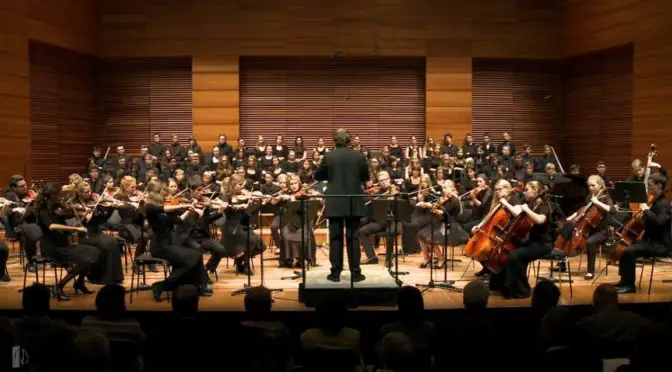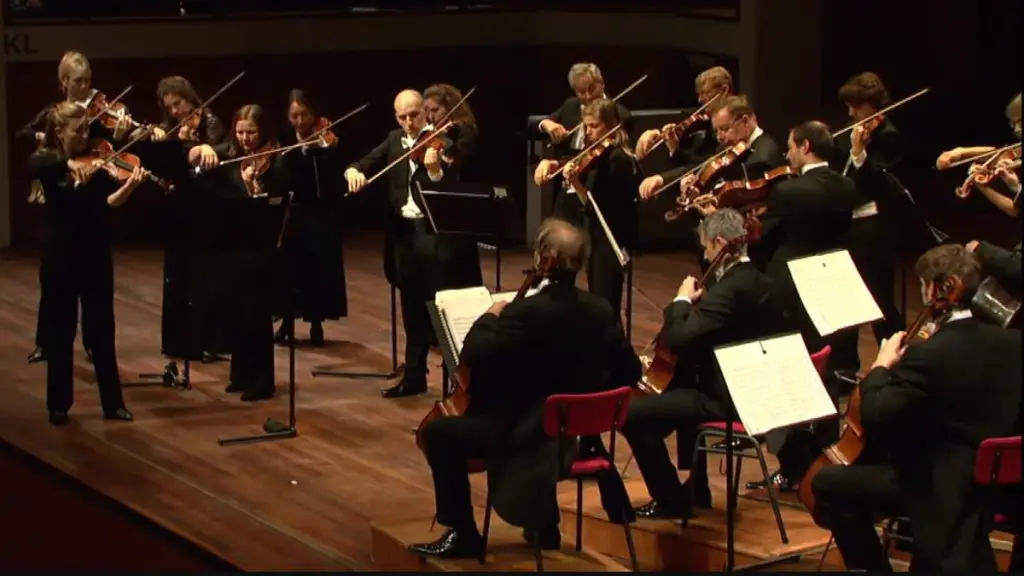Conducted by Joan Pagès Valls, the Orchestra of the Music High School Schloss Belvedere performs Edward Elgar’s Serenade for Strings in E minor, Op. 20, a piece for string orchestra in three short movements. This performance was recorded at the annual advent concert of the Music High School on December 4, 2014, at the Congress Centrum neue Weimarhalle, Weimar.
The Music High School Schloss Belvedere is a center for highly talented young musicians, where pupils attend courses and lessons held by professors of the University of Music FRANZ LISZT, Weimar.
Edward Elgar’s Serenade for Strings
Edward Elgar’s Serenade for Strings in E minor, Op. 20, is a captivating piece of chamber music that showcases the style of Elgar’s early compositional period. This work, composed in 1892, holds a special place in the British musical landscape, highlighting Elgar’s gift for melody and his deft handling of string orchestration.
The Serenade for Strings is one of Elgar’s earliest works to gain widespread recognition and remains one of his most frequently performed compositions. It was written during a particularly creative period in his life when he was beginning to establish himself as a significant figure in the classical music scene of England. This piece was composed shortly after he married Caroline Alice Roberts, and it is believed that the serenity and affectionate warmth of the music reflects his personal happiness at the time.
The composition’s structure is marked by its clarity and conciseness, which contrast with the expansive symphonies and concertos that would later define Elgar’s career. Although relatively modest in scope, the Serenade for Strings does not lack depth; it is imbued with a pastoral beauty and an elegance that are deeply characteristic of Elgar’s idiom.
The Serenade’s reception has generally been positive, appreciated both by critics and audiences for its charm and graceful craftsmanship. It quickly became a staple of string repertoire, admired for its lyrical beauty and the intimate emotions it evokes, which are typical of Elgar’s more introspective works.
Elgar’s approach to the Serenade for Strings highlights his mastery in the use of string instruments, weaving together lines that sing with a distinctly English tone. The work not only reflects his technical skill but also his ability to express profound sentiments through a relatively simple musical structure.
Today, the Serenade for Strings is often performed in concert settings, serving as a testament to Elgar’s early compositional prowess and his enduring appeal in the realm of classical music. It remains a beloved piece for its lyrical melodies, its refined atmosphere, and its heartfelt expression.
Movements
1. Allegro piacevole
The first movement of Edward Elgar’s Serenade for Strings, titled “Allegro piacevole,” sets the tone for the entire piece with its light, engaging character. This movement, as suggested by the marking “piacevole,” which means “pleasant” in Italian, is designed to be delightful and soothing. It opens with a gentle, flowing theme that is both lyrical and tender, showcasing Elgar’s ability to craft melodies that are both beautiful and emotionally resonant.
The texture of this movement is characterized by a playful interplay between the different sections of the string orchestra. Elgar utilizes a conversational style, with themes passed back and forth between the violins, violas, cellos, and basses, creating a rich tapestry of sound that remains transparent and airy. This interplay is underpinned by a rhythmic vitality that adds a subtle drive to the music without sacrificing its inherent grace.
Harmonically, Elgar explores a variety of keys and modulations, but always with a sense of naturalness and fluidity. The music flows seamlessly from one idea to the next, with each melodic and harmonic shift enhancing the overall mood of serene pleasure. The orchestration is masterful in its simplicity, avoiding over-complexity to maintain the movement’s light and engaging atmosphere.
2. Larghetto
The second movement of Edward Elgar’s Serenade for Strings, marked as “Larghetto,” is the emotional heart of the composition. This movement stands in contrast to the lighter, more buoyant first movement, delving into a deeper, more introspective mood. The “Larghetto” is often noted for its poignant beauty and is considered by many to be the core of the Serenade, reflecting Elgar’s capacity for profound emotional expression.
In this movement, Elgar employs a slow, lyrical melody that is rich in its expressive depth. The melody is introduced by the violins and is characterized by its long, singing lines that stretch over a harmonically rich accompaniment. The lower strings provide a subtle yet supportive backdrop, adding warmth and depth to the texture. The interplay between the upper and lower strings is less playful than in the first movement, instead adopting a more solemn and contemplative tone.
The overall structure of the “Larghetto” is simple yet effective, with Elgar’s use of repetition serving to deepen the emotional impact of the thematic material. The dynamics are carefully controlled, with crescendos and diminuendos used to enhance the expressive quality of the music. The movement progresses with a sense of organic growth, where each phrase builds upon the last, culminating in moments of heartfelt intensity before receding into more subdued passages.
Harmonically, Elgar navigates through a landscape that enhances the nostalgic and somewhat melancholic mood of the movement. The harmonic shifts are subtle yet poignant, emphasizing the introspective nature of the music. This movement showcases Elgar’s skill in creating an atmosphere that is at once intimate and expansive, drawing the listener into a reflective emotional space.
The “Larghetto” concludes with a gentle fading away of sound, leaving a lasting impression of serenity mixed with a touch of sadness. This movement not only highlights Elgar’s mastery of string orchestration but also his ability to convey deep emotions through music, making it a central and cherished part of the Serenade for Strings.
3. Allegretto
The third movement of Edward Elgar’s Serenade for Strings, marked “Allegretto,” serves as a lively and spirited finale to the composition. After the introspective and deeply emotional second movement, this concluding part brings a sense of closure and rejuvenation with its upbeat and brisk tempo.
The “Allegretto” is characterized by its light and playful nature. It begins with a rhythmic motif that immediately sets a cheerful and almost dance-like atmosphere. This motif is cleverly interwoven throughout the entire movement, providing a cohesive rhythmic foundation that propels the music forward. The themes introduced here are more energetic and pronounced compared to the gentle flows of the previous movements, reflecting a return to the more buoyant spirit of the first movement but with added vigor.
Elgar’s orchestration in this final movement is masterful, showcasing his ability to draw out rich textures from the string ensemble. The interplay among the violins, violas, cellos, and basses is particularly dynamic, with quick exchanges and playful counterpoints that enhance the overall sense of liveliness. The movement is filled with rhythmic vitality, with frequent changes in dynamics and articulation that keep the listener engaged and energized.
Harmonically, the “Allegretto” is inventive yet accessible, with Elgar employing a variety of harmonic changes that surprise and delight. These changes support the playful character of the movement and maintain a light-hearted feel throughout. The movement does not delve into the depth of emotion found in the “Larghetto” but instead focuses on creating a joyful and exuberant conclusion to the Serenade.
The movement concludes with a brisk and joyful ending, rounding off the Serenade for Strings with a sense of completeness and satisfaction. This final movement highlights Elgar’s versatility as a composer, capable of conveying a wide range of emotions and atmospheres within a single work. It leaves the audience with a feeling of upliftment and demonstrates why the Serenade remains a favorite in the string repertoire, celebrated for its melodic beauty and emotional depth.
Sources
- Serenade for Strings (Elgar) on Wikipedia
- Serenade for String Orchestra, Op.20 (Elgar, Edward) on the International Music Score Library Project website
- Elgar Serenade for String Orchestra, Op. 20 on the Musopen website

